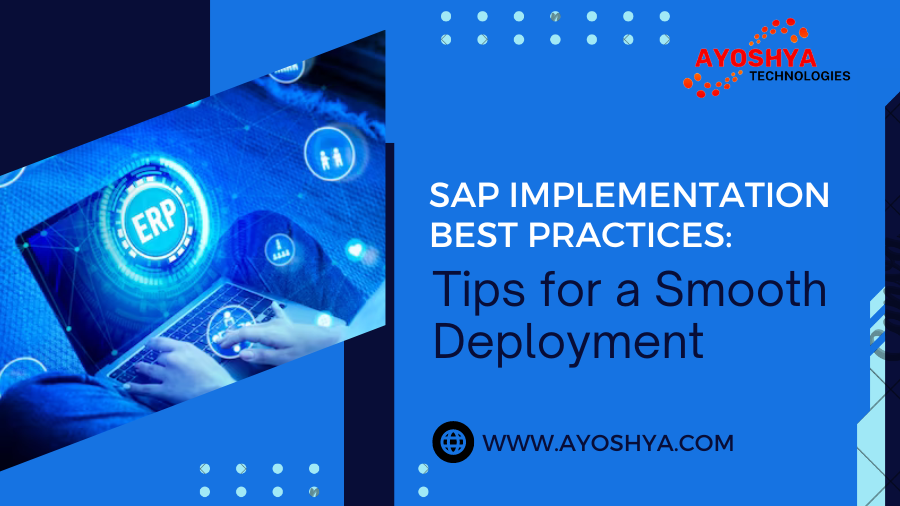SAP Implementations Best Practices: Tips for a Smooth Deployment
Introduction to SAP Implementations:
SAP Implementations refers to the process of integrating SAP (Systems, Applications, and Products) software into an organization’s existing infrastructure to enhance operational efficiency, streamline processes, and gain valuable insights for decision-making. It is a significant undertaking that requires meticulous planning, strong leadership, and seamless execution to ensure a successful deployment.
Selecting the Right SAP Solution:
To start a successful SAP Implementations journey, businesses must carefully evaluate their unique requirements and select the appropriate SAP solution. This involves assessing various aspects of their operations and choosing the right SAP modules that align with their business needs.
Assessing Business Needs: Understanding the organization’s pain points, challenges, and growth objectives is crucial in determining which SAP modules will be most beneficial.
Evaluating SAP Modules: SAP offers a wide array of modules tailored to different business functions. Evaluating each module’s functionalities and mapping them to specific business processes helps in making informed decisions.
Building a Strong Project Team:
A robust project team is the backbone of a successful SAP Implementations . Identifying key stakeholders and appointing competent project managers are essential steps.
Identifying Key Stakeholders: Involving representatives from various departments ensures that all aspects of the business are considered during implementation.
Appointing Project Managers: Competent project managers with expertise in SAP implementation and strong leadership skills are vital for guiding the team effectively.
Comprehensive Planning and Preparation:
Thorough planning and preparation lay the foundation for a smooth SAP implementation. Defining project scope, objectives, and creating a realistic timeline are key components.
Defining Project Scope and Objectives: Clearly defining the project’s scope and objectives helps manage expectations and avoids scope creep during the implementation process.
Creating a Timeline and Milestones: Developing a detailed timeline with achievable milestones ensures that the project stays on track and progress can be monitored effectively.
Data Migration and Cleansing:
Data migration is a critical aspect of SAP implementation as it involves transferring existing data into the new system. Ensuring data accuracy and integrity is paramount.
Assessing Data Requirements: Identifying the necessary data for migration and determining data sources are crucial for a successful data migration process.
Ensuring Data Integrity: Cleansing data, removing duplicates, and validating data accuracy are vital to prevent data-related issues post-implementation.
Thorough Testing and Quality Assurance:
Comprehensive testing and quality assurance play a pivotal role in detecting and resolving issues before SAP deployment.
Unit Testing: Conducting unit testing to verify the functionality of individual components within the SAP system.
Integration Testing: Performing integration testing to ensure seamless communication between different modules and systems.
User Training and Change Management:
Preparing end-users for the transition to the new SAP system is crucial to ensure a smooth adoption process.
Preparing Users for the Transition: Providing comprehensive training to end-users, familiarizing them with the new SAP system, and addressing their queries.
Managing Resistance to Change: Implementing change management strategies to address resistance and ensure a positive transition experience for employees.
Gradual Deployment and Phased Approach:
A gradual and phased approach to SAP deployment allows organizations to minimize disruptions and manage risks effectively.
Piloting in a Controlled Environment: Starting with a pilot phase in a controlled environment to identify potential issues and fine-tune the system.
Expanding to Other Departments: Gradually expanding the implementation to other departments or business units to ensure a gradual and well-managed deployment.
Constant Monitoring and Support:
Continuous monitoring and providing ongoing support post-implementation are essential for the system’s smooth functioning.
Monitoring Key Performance Indicators: Tracking key performance indicators (KPIs) to evaluate the system’s performance and identify areas for improvement.
Providing Ongoing Support: Offering post-implementation support and resolving issues promptly to maintain system efficiency.
Post-Implementation Review and Optimization:
After SAP implementation, conducting a post-implementation review is vital to evaluate the project’s success and identify areas for further optimization.
Assessing Project Success: Conducting a thorough assessment of the project’s success against predefined objectives.
Identifying Areas for Improvement: Identifying opportunities for further optimization and continuous improvement.
Conclusion:
SAP implementation is a significant undertaking that requires careful planning, execution, and dedication. By following best practices, organizations can ensure a smooth deployment and reap the benefits of an integrated and efficient SAP system. The key lies in selecting the right SAP solution, building a strong project team, and embracing a comprehensive and phased approach to implementation.
FAQs:
- How long does an SAP implementation process typically take? The duration of SAP implementation varies based on the organization’s size, complexity, and scope of the project. It can range from several months to over a year.
- What are some common challenges during SAP implementation? Common challenges include data migration issues, resistance to change from employees, and integration complexities with existing systems.
- Is SAP implementation suitable for small businesses? Yes, SAP offers solutions tailored to the needs of small and medium-sized businesses, enabling them to streamline processes and improve efficiency.
- Can organizations customize SAP modules to meet specific requirements? Yes, SAP modules can be customized and configured to align with an organization’s specific workflows and processes.
- How can organizations ensure a successful post-implementation phase? Regularly monitoring system performance, providing ongoing support, and seeking feedback from end-users are essential for a successful post-implementation phase.



